Knowing the benefits, you’ll likely be investing resources into crafting compelling email newsletters already.
Newsletters forge a personalized connection, something often missing in other forms of communication. This fosters an engaged audience, cultivating trust and ongoing interaction among subscribers.
If you’ve been at this for a while, you’ve likely considered how to monetize a newsletter. After all, many newsletter creators achieve significant success through email monetization strategies.
You’re in the right spot if you’re eager to join their ranks. In this article, we’ll explore ways to make money by emailing. Additionally, we’ll offer valuable insights into the overall revenue potential of newsletters.
Let’s get started.
Understand your audience
Targeting the right audience guarantees that your content resonates effectively. Here are two effective strategies to achieve this and grow your newsletter’s impact.
Pinpoint your audience’s interests
Your audience’s preferences should shape your content strategy right from the start.
If you haven’t done so already, develop a pool of buyer personas tailored to your business. Consider the following questions:
- Who are the primary recipients of my newsletter?
- What are their interests and pain points?
- How does my content address their interests?
- What tone and style resonate best with my audience?
- What types of content have elicited the most engagement in the past?
Pinpointing audience interests helps you create highly tailored content. This can lead to higher open rates, click-through rates, and, ultimately, more conversions.
Imagine you’re selling a fitness app. Your audience will likely include gym enthusiasts. They’ll have specific goals like building muscle or training for a marathon.
Knowing this, you could promote affiliate products like workout equipment and nutritional supplements. This is a great way to capitalize on your audience’s interests and generate additional revenue.
Harness the power of audience segmentation
Audience segmentation is vital for delivering content that hits the mark. It helps provide a personalized experience, which boosts email revenue.
Segmenting your list requires effort and careful consideration. To start, use available data to categorize your audience based on factors like:
- Age
- Gender
- Interests
- Location
- Purchase history
Once categorized, create separate email lists for each group. Let’s consider a fashion blogger who segments her audience based on their browsing behavior.
For sustainability enthusiasts, she promotes eco-friendly brands. Conversely, for luxury seekers, she highlights high-end products. This strategic approach enhances the likelihood of her newsletter generating revenue.
Email monetization strategies
So, how do newsletters make money? Here are nine effective strategies, regardless of business size, industry, or audience demographics.
1. Subscription models for exclusive content
Charging a fee for exclusive content is a reliable way to earn predictable revenue from your newsletter. This can range from exclusive articles to eBooks or digital templates. The essential focus is on understanding why one would pay for such content.
To start a paid newsletter, consider offering a free version with limited features. Alternatively, you can provide a free trial. This can generate interest and give subscribers a taste of what to expect.
Polls and surveys can also help gauge interest and tailor paid content accordingly.
Among the top paid newsletters is The Audacity. This newsletter is dedicated to supporting underrepresented American writers.
The Audacity offers a monthly subscription starting at $5. It has thousands of readers, with many likely paying for the subscription. Paid subscribers gain access to exclusive content, a community, events, and more.
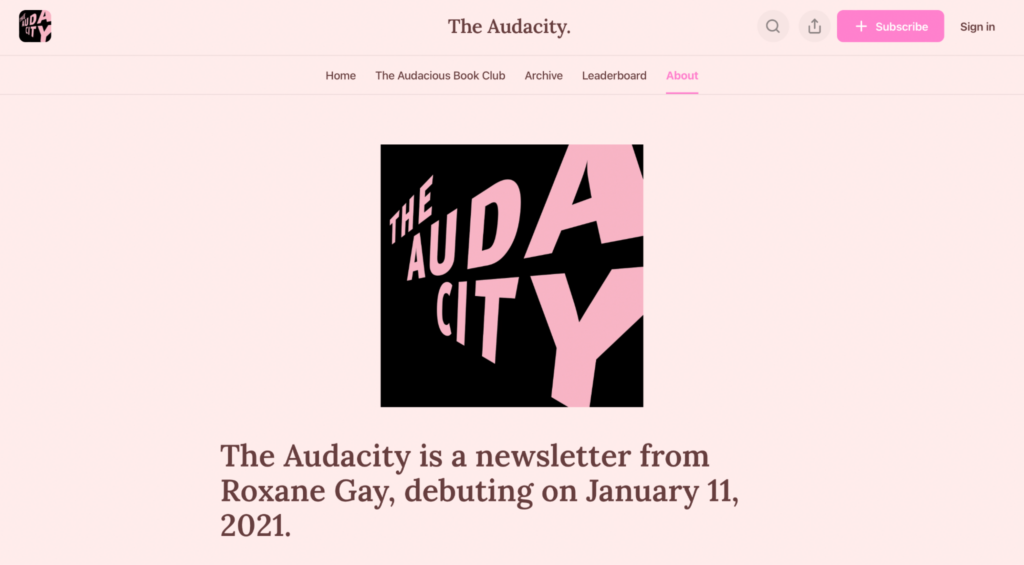
Image via Substack
This newsletter utilizes Substack, an online platform providing infrastructure for subscription newsletters. It offers publishing, payment, analytics, and design support to newsletters. Other similar platforms worth considering include Ghost, Revue, and Memberful.
2. Sponsored content and advertisements
Another effective way to monetize your newsletter is through sponsored content and advertisements. This involves allowing brands to pay for placement within your newsletters.
However, ensuring that sponsored content aligns with your subscribers’ interests is crucial. This maximizes engagement and increases the likelihood of purchases or sign-ups.
The result would be a positive return on investment (ROI) for your sponsor. This would make them more likely to continue sponsoring your newsletter.
Moreover, sponsored content must seamlessly blend with the newsletter’s overall tone and style. Neglecting this may result in a negative experience for recipients, leading to unsubscribes.
The Woodworkers Guild of America newsletter often opts for a sponsored content model. Woodmaster Tools, a leading woodworking machinery manufacturer, sponsored a recent edition.
The newsletter prominently features the sponsored brand’s name. There’s also a video and a brief pitch of its offerings. This format is often called a “deep dive,” dedicating the entire newsletter to a sponsor.

Image via Milled
Alternatively, you may opt for classifieds in your newsletter. Here, sponsors are featured in brief text blocks. You can also use shoutouts, where sponsors are featured through multiple links.
3. Selling special editions or reports
Some newsletters provide exclusive content for standalone purchases. This is unlike paid subscriptions, as it’s usually a one-time purchase.
The benefit of one-time special edition newsletters is that they’re more flexible. This is a great option for subscribers who don’t want to commit to a recurring subscription.
Here are some tips on how to monetize a newsletter using this approach:
- Choose compelling themes for your special editions to attract subscribers’ interest.
- Set an enticing pricing strategy for the special edition to encourage purchases.
- Provide added value, such as bonus content or access to a community.
- Consider bundling multiple special editions together to increase sales.
Finance newsletters often provide special editions. For instance, these may offer a detailed analysis of upcoming stock market trends.
Subscribers could buy this standalone report for a one-time fee. This grants them exclusive insights and forecasts unavailable in regular newsletter content.
4. Sell merchandise
This monetization technique holds promising potential if you have a dedicated subscriber base. It entails selling merchandise that resonates with the newsletter’s theme or brand identity.
Branded merchandise examples include apparel, accessories, and various other items.
Here are some advantages of this monetization strategy:
- Brand promotion: Having subscribers don your merchandise helps boost brand exposure.
- Fostering community spirit: Observing fellow subscribers sporting the same merch fosters a sense of belonging among your audience.
- Creative expression: Merchandise allows for creative expression and customization. This way, you can cater to diverse subscriber preferences.
Once more, the crucial question to consider is, “Does this product fulfill my readers’ needs?” Accordingly, dedicate some time to determine what offerings to provide.
Once done, craft an email pitch articulating why they should buy from you. Enhance your persuasion by including testimonials from satisfied customers.
Morning Brew serves as a prime example in this context. They produce and market high-quality branded merchandise that resonates with their readers.
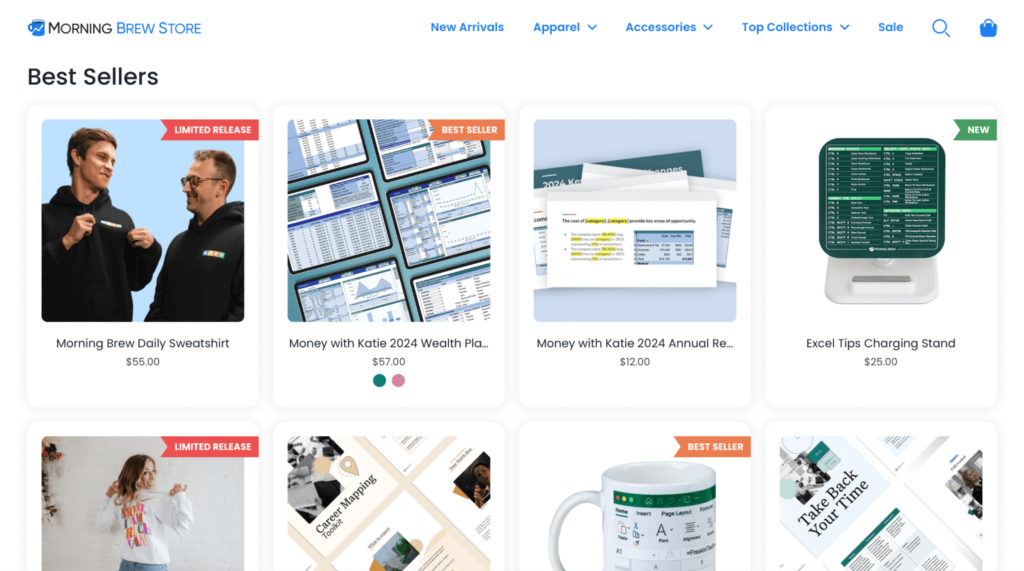
Image via Morning Brew Store
However, selling merchandise may not be suitable for every newsletter. It’s unlikely to be profitable for smaller ones. But it’s worth considering as your newsletter gains traction and expands.
5. Crowdfunding and donations
Asking for donations is one of the most straightforward methods of monetization. This differs from paid subscriptions, which provide exclusive content or benefits for payment.
Donations rely solely on goodwill. Encouraging your supporters to donate is perfectly acceptable. If they are willing, it demonstrates their appreciation for your work.
Moreover, this approach may be very effective for newsletters affiliated with social enterprises.
Here are some expert tips on how to monetize a newsletter via donations:
- Offer exclusive content: Provide donors with special incentives. These could include early access to content, Q&A sessions, or behind-the-scenes updates.
- Communicate value: Clearly explain how reader contributions sustain and enhance newsletter quality.
- Set transparent goals: Define how contributions will be used, fostering trust.
- Integrate donation options: Display donation buttons or links prominently for easy access.
Numerous platforms are available to facilitate reader support. This can be through one-time contributions or ongoing backing. Examples include Patreon, Ko-fi, and Buy Me a Coffee.
Freelance writer Rachael Pilcher operates Mighty Freelancer, a newsletter catering to SaaS content writers and copywriters. She always includes a Buy Me a Coffee link at the end of her emails.
Notice how the donation link is accompanied by a brief message encouraging support. It essentially says, “If you found value in the newsletter, consider supporting it.”
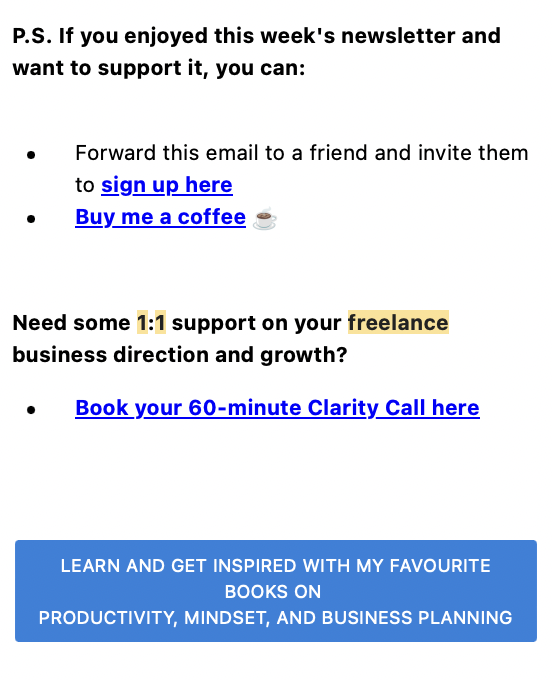
Image via Mighty Freelancer
6. Affiliate marketing
Promoting affiliate offers means endorsing products or services from other businesses. This way, your newsletter can get you commissions for referred purchases.
However, ensuring relevance to your brand and value to your readers is crucial. Avoid promoting products solely for the sake of earning commissions. Here are some tips for doing so:
- Choose products directly related to your niche.
- Gather audience preferences to inform product selection.
- Ensure selected products meet quality standards and provide value.
- Evaluate payment terms and cookie durations for commission rates.
- Familiarize yourself with affiliate program terms and conditions.
Following these tips can increase your chances of boosting affiliate sales.
Additionally, fostering trust and ensuring compliance is crucial. It’s important to disclose your affiliate partnerships to your audience.
For example, National Geographic frequently incorporates affiliate product links into its email newsletter. In one such email, they promote products designed to aid viewing the sun and solar eclipses.
The email includes an image, a brief product description, and a CTA button. Notably, this email was sent when a solar eclipse was imminent. Timing plays a crucial role in monetizing your newsletter effectively.
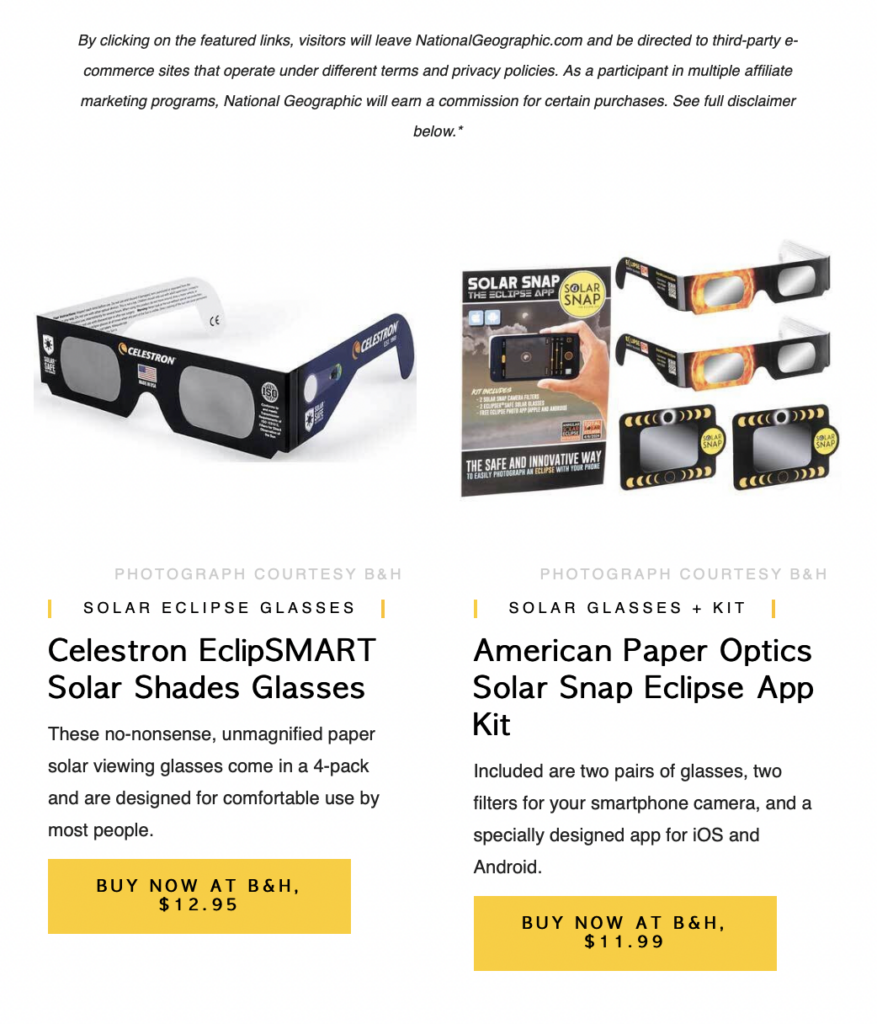
7. Promoting your products or services
The most direct way to make money from your newsletter is by selling products. These can include digital products like eBooks, merch, or even workshops.
Many newsletter owners also offer services such as consulting and coaching. This is a great approach if you have skills that appeal to your audience.
Suppose you manage a newsletter focusing on digital marketing. In such a scenario, you could consult with subscribers to enhance their online presence. This is a smart way to make money and also establishes you as a subject matter expert.
Regardless, refrain from promoting products in every issue. The focus must be on providing genuine value.
Here, we have a newsletter from Moment, a marketplace for photographers and filmmakers. It is showcasing mini lessons from a past workshop for purchase.
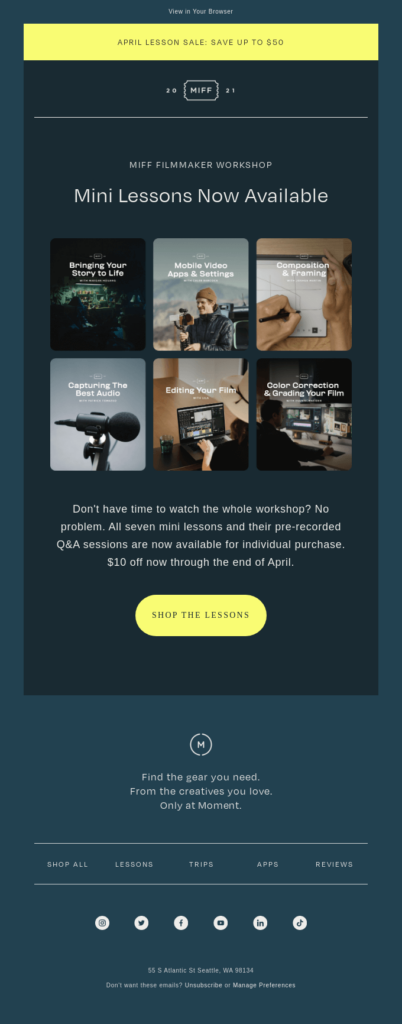
Image via ReallyGoodEmails
To drive urgency and increase sales, consider offering discounts. In this instance, Moment offers subscribers a $10 discount until April.
Additionally, thoroughly test your fulfillment process before sending the newsletter:
- Make test purchases to confirm subscribers can complete payments.
- Click your CTA links to ensure they direct subscribers correctly.
- For digital products, confirm that subscribers receive the correct items post-payment.
8. Collaborating for cross-promotions
Cross-promoting in newsletters can be a powerful monetization strategy. It allows brands to tap into each other’s subscriber bases, expanding exposure to new audiences.
For instance, a fitness apparel brand might collaborate with a nutrition supplement company. They could co-create a newsletter featuring workout tips paired with recommended supplements. This will benefit both brands’ audiences.
Here’s how to effectively engage in this strategy:
- Identify compatible partners: Seek out brands in related niches. Ensure that they share a similar target audience to yours.
- Establish mutual benefits: Clearly outline the advantages for both parties. Examples include gaining access to each other’s subscriber base and better brand visibility.
- Plan collaborative content: Develop co-branded newsletters, exclusive offers, or joint campaigns. It’s crucial to maintain your brand voice and ethos throughout the collaboration.
- Measure success: Track the performance of cross-promotional activities within your newsletters. This will help you evaluate their impact on subscriber engagement and revenue generation.
In the example provided, BetterBrand capitalizes on Valentine’s Day by initiating a partnership. Teaming up with Cometeer Coffee, they distribute a newsletter about their collaboration.
BetterBrand extends a $20 discount coupon to its subscribers for their first Cometeer purchase.

Image via ReallyGoodEmails
9. Conducting paid webinars and educational content
Offering paid webinars or courses is a potent method of monetizing your expertise. The best part is that these can be scaled to accommodate many participants, boosting revenue without significant additional effort.
Moreover, subscribers gain access to valuable learning opportunities. This is an effective way to increase subscriber satisfaction and loyalty.
Start by identifying a niche area of expertise that resonates with your audience. Make sure that it exhibits demand for educational content. Accordingly, develop high-quality, comprehensive educational materials.
Also, ensure that your email clearly outlines workshop details. This may include the date, time, agenda, speakers, and any guidelines.
Take inspiration from Filtered, an AI hiring software. Its newsletter effectively promotes its upcoming workshop on building an effective tech stack. The information contained in the email is concise yet comprehensive.
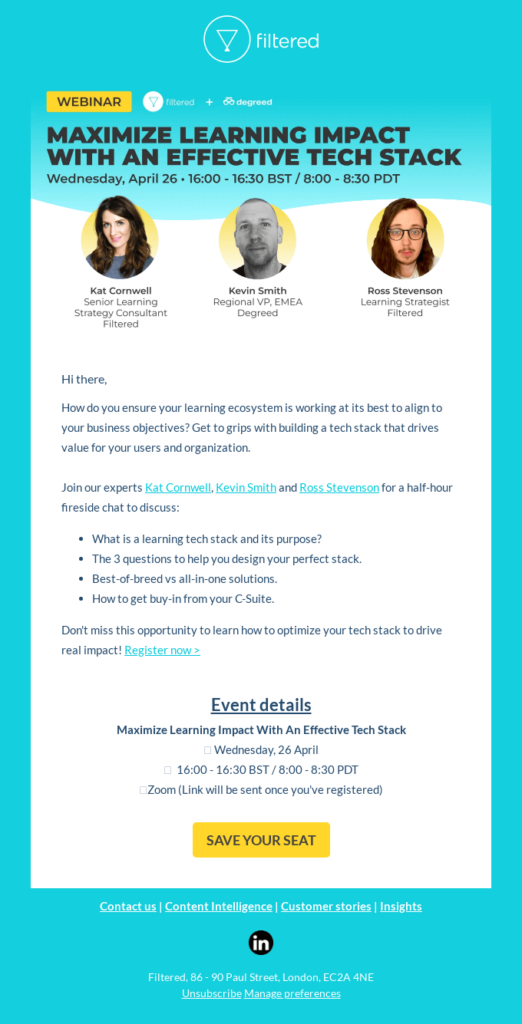
Image via ReallyGoodEmails
When setting pricing structures, ensure they reflect the value of your content. That said, they must be accessible to your target audience. You can even offer tiered pricing options or early bird discounts to boost sign-ups.
Now that you know how to make money with a newsletter, let’s explore the financial aspects of the business in more detail.
Estimating revenue potential
Different newsletters will generate varying revenue amounts. A recent analysis by Press Gazette highlights this. It reveals that at least five Substack newsletters generate $1 million annually. Conversely, others provide insufficient income for livelihoods.
In essence, the newsletter business doesn’t guarantee fixed revenue. This is because there are many varying factors at play, including:
- Audience size: The number of subscribers directly impacts revenue potential. Larger audiences generally correlate with higher earnings.
- Engagement rates: Subscriber interaction and involvement influence revenue. Naturally, highly engaged audiences are more likely to respond to monetization efforts.
- Chosen monetization strategies: The method of monetizing the newsletter also matters. For instance, a specialized industry newsletter could thrive with sponsored content. Conversely, a general-interest newsletter might find more success with tiered subscription models.
Cost considerations
Running a newsletter campaign may be more cost-effective than anticipated. Here are some factors that will impact overall cost:
- Platform fees: These encompass expenses for hosting and managing the newsletter. This can vary greatly based on the chosen service provider.
- Content creation expenses: This covers costs associated with creating engaging content. Examples include hiring writers and graphic designers or purchasing stock images.
- Marketing costs: These entail expenses for promoting the newsletter to attract subscribers. It covers activities like social media advertising or email marketing campaigns.
Email monetization success stories
Top-tier newsletters have the potential to generate tens of thousands of dollars monthly. Here are some notable newsletter creators for inspiration:
- Side Hustle Nation: Side Hustle Nation is a newsletter with over 200,000 subscribers. It covers various topics on side hustles and entrepreneurship. The newsletter earned over $200,000 in ad revenue in 2022.
- The Hustle: Take inspiration from The Hustle to monetize through merchandise and courses. In 2022, this approach helped the newsletter earn over $50,000 in revenue.
- Smart Passive Income: Smart Passive Income focuses on online business and passive income. With over 500,000 subscribers, it earned over $100,000 in affiliate marketing revenue in 2023.
- Morning Brew: This is one of the most popular newsletters, with over 4 million subscribers. In 2023, it generated over $1 million in revenue solely from premium subscriptions.
There are numerous ways to monetize a newsletter. Experiment with different strategies to determine what yields the highest ROI for you.
How to monetize a newsletter: Wrap up
Knowing how to monetize a newsletter is crucial for creators aiming to turn their passion into profit. There are several options, from offering paid memberships to selling ads.
Alternatively, you can use more direct methods to make money by sending emails. These include affiliate marketing or promoting seasonal offers. You can even use multiple monetization methods to maximize earnings from different subscribers.
In any case, it’s crucial to prioritize valuable content over profit-centric initiatives. Always keep engagement at the forefront.
Make it a point to analyze metrics like impressions and clicks to optimize content. This way, you’ll be able to identify strategies that bring you the highest ROI.
